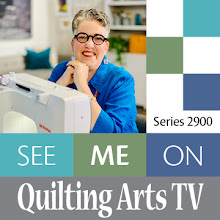We worked inside today, with professional flash units and light stands, and pinned each piece to my design wall. We rigged nylon fabric over the flash units to soften and diffuse the light. We bounced the lights at a 45 degree angle off foamcore positioned at the sides of the pieces. We tried putting one flash to the side, to skim light over the surface (the result was hot spots, or bright areas, near that flash, even at lower settings). We experimented with setting the flashes at different power settings. I shot in manual mode, and I played some with my f-stop and my shutter speed and my ISO. You can see the result here:
The color is fairly close. The light is even, and I think the exposure is okay. But it is totally flat. When you zoom in, the detail is okay, and you can see the stitching, but it looks like a painting and not a quilt.
If you look at the photo at the top of this post, you can see a photo I took a few months ago of the same piece. The texture is great. I took it outside. I put it on the ground, got up on a ladder, and shot straight down. It was a sunny day, and either early morning (9-ish) or later in the afternoon (4-ish) to avoid the harsher lighting of mid-day. I shot in auto mode.
If you read my post earlier this month, you can see the little foam core “stage” I set up to shoot my smaller pieces and how-to shots. This quilt is too big to fit on that stage, so it had to be shot in a different way.
So… here’s my big question: Why is the first shot so much better? What am I doing wrong when I shoot inside? If you know and can help me, please leave a comment! I’d really like to have some of my hair at the end of the month. Thanks.
LATER NOTE: Here is Holly's response to my plea for help:
"Hi Susan! I hear your frustration! Just checked out your blog post and you are certainly doing all the right things. It’s all in the lighting. You have to light one side brighter than the other, to create little shadows from the raised areas in-between your quilting lines. The only thing I can think of is that even though you’ve tried different lighting scenarios, that perhaps you’ve evenly lit *both* sides of the piece. You’ll want one side to be lit a little brighter than the other. I’m guessing that your quickie shot taken outdoors that shows the quilting fabulously worked because the sun was hitting it at an angle. Perhaps try moving one light stand close to the quilt and aiming it at a 25-degree angle across it, and move the other light stand to the other side of the quilt but farther away, 45-degree angle as you normally would, just to make sure that side of the quilt isn’t in total darkness. Possibly even try a brighter bulb in the light closest to the quilt. See this very quick graphic in case this doesn’t make sense:
"Also, you mentioned using flash units. Are they literally flashes, that only go off when the shutter clicks? I never use those myself (unless I’m taking a quickie auto shot) because I can’t see the light before it goes off (compared to the fixed lights on the stands that you can move around and judge brightness with because they’re always on). "
Thanks, Holly! I guess it is back to the drawing board! Stay tuned, everyone!















